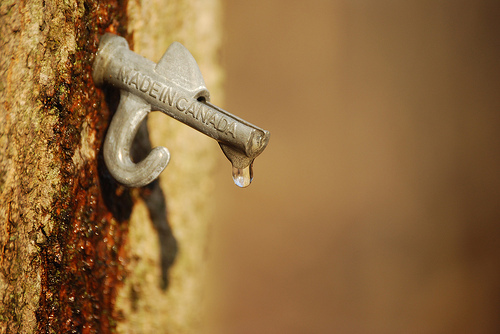Sugar Maple : Sugaring: Physiology
Sugar maples are culturally and economically important throughout the Northeast for several reasons. The image most often associated with these trees is maple syrup and the act of sugaring. Every spring, when daytime temperatures reach 40°-45° F and nighttime lows hover around 20° F, people throughout the Northeast begin tapping trees to collect the sweet sap. This typically happens towards the end of February or beginning of March and lasts around four or six weeks. In Vermont, the traditional first day of sugaring has been Town Meeting Day, the first Tuesday in March. While many trees produce sap of some variety, that of sugar maples (and red and black maples to a lesser extent) is unique in a couple of ways. First, the raw sap is unusually sweet, averaging about 2%-3% sugar content. Taken straight from the tree, it tastes like slightly sweet water, with subtle maple undertones. Incidentally, a favorite springtime treat in some areas is something my family calls a sapsicle, which is effectively an icicle that forms when a maple branch is injured, allowing sap to leak out and freeze. If you can find one, you suck on it like a Popsicle.
Second, and almost as importantly, is the way in which maples store energy in the fall and how cells react to temperature variations. As the growing season comes to an end in early autumn, the tree stops expending energy to increase in height or diameter and begins to store food for the winter and spring. This food is stored in the ray cells of the tree as carbohydrates. As the weather warms in the spring and the tree begins to awake from dormancy, the carbohydrates are hydrolyzed to become sucrose, a simple sugar that the tree can use to produce leaves and flowers. This sugar is transported to the xylem cells in the form of sap, which the tree metabolizes, producing carbon dioxide. When the temperature rises above 40° F, this gas begins to be expelled from the sap and the xylem cells and forced into the intercellular spaces. This increases the pressure within the tree, forcing the sap to flow from the top of the tree down to the bottom, the reverse of the normal upwards flow of water from the roots. If the cells are cut by a tap, the pressure will force the sap out of the tree. During the night, the sap stops running as metabolic processes stop and cooler temperatures allow carbon dioxide to be reabsorbed by the sap, reducing pressures. As temperatures start to stay warm and trees start to leaf out, the sap flows begin to decrease and take on unpleasant, buddy flavors.

